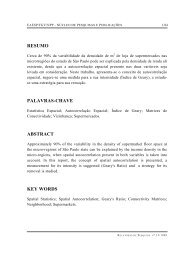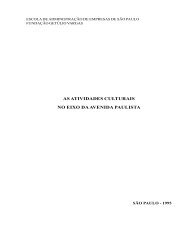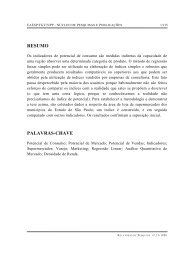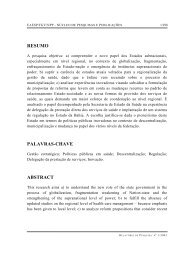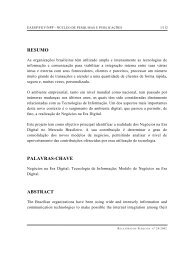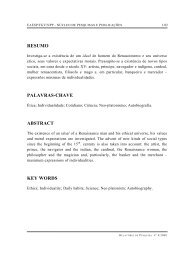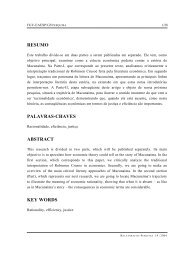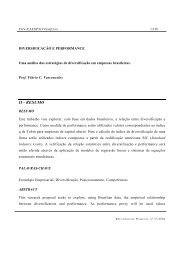THE EFFECT OF GUIA EXAME'S RATINGS ON THE ... - fgv-eaesp
THE EFFECT OF GUIA EXAME'S RATINGS ON THE ... - fgv-eaesp
THE EFFECT OF GUIA EXAME'S RATINGS ON THE ... - fgv-eaesp
Create successful ePaper yourself
Turn your PDF publications into a flip-book with our unique Google optimized e-Paper software.
FGV-EAESP/GVPESQUISA 6/13“mirror” fund (a fund constituted by one institution with the purpose to distribute FIFs fromthird parties);3. It cannot be free of administration and performance charges concomitantly;4. It must be open to investment and be amongst the one-thousand biggest net-worth fundsin the industry;5. Net-worth should not show excessive movements just before the ranking closing date(there is a specific methodology defined by the authors of the guide to determine what areconsidered “excessive movements” prior to the rating closing date).In the guide the selected funds are then separated according to their ANBID category, andthen between wholesale and retail funds. Subsequently, the funds are analyzed according totheir nature: active or passive, and then respectively scrutinized according to the GeneralizedSharpe Ratio (Sharpe, 1994) or according to average square minimum errors. The benchmarksused are the IBOVESPA (São Paulo Stock Exchange Index), the IBX (another São Paulo StockExchange Index), PTAX-800 (Brazilian Reais to US dollar exchange rate) and the CDI (Brazilianinter bank deposit certificates, which is a proxy for fixed income markets base rates). The“stars” are given to funds according to the ranking of 10% top performance funds that aregranted five stars, the next 15% receiving four stars and three, two and one stars being given tothe next blocks of 25% of all funds listed. All funds with a negative Generalized Sharpe Ratioreceive automatically one star.Our analysis was performed in four stages, in order to explore different categorizations. Wefirst analyzed the funds according to the stars assigned by the Guia Exame and then accordingto four asset classes: fixed income, equity, multi-market and balanced funds (mostly hedgefunds) and others (all funds that could not be assigned to one of the other categories). Next, weinferred possible effects associated with size (splitting the whole industry into big, mediumsized,small and “boutiques”), and then by fund size (now splitting the fund sample by networth in big, medium, small and very small) type of investor (retail and wholesale. Weorganized the tests according to the below described segmentation:1. Star ranking (one to five stars) by Fund Category (fixed income, equity, multi-market andothers);2. Star ranking by Asset Manager size (less than R$15m, between R$15m and R$50m,between R$50m and R$500m, and above R$500mm of assets under management.);3. Star ranking by Fund Size (smaller than R$15mm, between R$15m and R$50m, betweenR$50m and R$500m, and above R$500mm invested in the fund) by Fund Category;R ELATÓRIO DE P ESQUISA Nº 08 /2008



